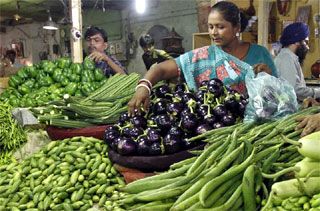Will the 6 per cent inflation target be met?
 What a difference a quarter makes. Back in August, markets were fretting about inflation overshooting the Reserve Bank of India (RBI)'s near-term target of 8 per cent. The monsoon was 20 per cent below normal, oil was above $100/barrel, and many hoped growth was on an upswing. Three months later, the tables have turned.
What a difference a quarter makes. Back in August, markets were fretting about inflation overshooting the Reserve Bank of India (RBI)'s near-term target of 8 per cent. The monsoon was 20 per cent below normal, oil was above $100/barrel, and many hoped growth was on an upswing. Three months later, the tables have turned.
The monsoon made a dramatic recovery in September, improving the outlook on food prices, oil has collapsed to below $80/barrel allowing diesel prices to be cut by 10 per cent, and growth remains weak (with July-September growth tonight likely at or below 5 per cent), which has helped push down core inflation.
Further, both the old and new administration have taken encouraging steps on the food front: Minimum support prices have increased by only 3-5 per cent over the last three crop cycles, and the new government is far more willing to sell rice and wheat from its buffer stocks to augment market supplies. Given all this, inflation in recent months - even adjusting for base effects - has undershot projections. Markets now believe the 6 per cent target will be reached beforehand and the clamour for rate cuts has begun.
The question that needs to be asked, however, is given the new reality, whether monetary policy can be eased and the 6 per cent inflation target still be met? That, in turn, depends on a judgement about what fraction of the recent disinflation is cyclical and what fraction is structural. Most will concur it's largely cyclical. If and when growth accelerates pricing power and core will likely pick-up, unless input costs continue to moderate. Oil prices could easily reverse.
And, while there is clearly a structural element to food (lower MSPs), the true test will be whether protein and vegetable inflation can be contained on a sustained basis. To be sure, inflation is currently benefiting from the perfect storm, and this potentially opens space for modest easing in 2015: 25-50 basis points, which we believe will likely come after the Budget, though a move next week cannot be completely ruled out.
But markets must realise that time for deeper cuts has not come. Higher growth in the coming years will need higher real rates to finance. And higher real rates are only compatible with lower policy rates, if inflation moderates even further. And that, in turn, will need significant supply-side augmentation, on the food and manufacturing front which will take some time.
Only then can the disinflation be considered structural and enduring. Policymakers have fought the good fight over the last 18 months. Now let's take the macroeconomic adjustment to its logical conclusion.
Sajjid Z Chinoy is Chief India economist, JP Morgan


.jpg)








